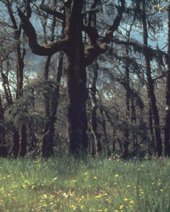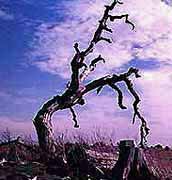Large specimens can be 75-100 feet height with trunks up to five feet in diameter. These trees can be 500 years old, and even smaller trees only 30 feet high can be 200 years old.
The other native oak in the Northwest is the California Black Oak. Q. kellogii Though faster growing, it is shorter lived, but as they will live some 200 or 300 the gardener should have little reason to complain.
I find it interesting that people plant fast growing, disease prone large trees such as Black Locust or Willow and chose to ignore the Oak. Not only do these trees drop equal or greater litter, their root systems are a total menace to the garden beneath.
Other Oak tree facts and Links
Seed dispersal
The largest White Oak tree is or was?
The largest Garry Oak was on Salt Spring Island, B.C. Canada
Oak Woodland Management in California
Oak trees are of major importance to both man and wildlife. Here in the Pacific Northwest The Garry Oak, Quercus Garryana is one of our most stately trees. It is also a food source or habitat zone for many wildlife species. Their acorns are highly critical when other foods are scarce. When the acorn crop fails many a linked wildlife species suffer. Squirrels and other rodents store their acorns for winter use, they in turn are preyed upon by other species. Deer also browse on the foliage and twigs and are preyed upon by the cougar.
In addition to food value, the heavy litter produced by the tree provides wildlife cover for a great many other plant species. The leaves and twigs are used by birds as nesting material.
We need to do much more as our wetlands, marshes and wild areas become ever more diminished. I used to live on Lulu Island, near Vancouver B.C. It was alluvial soil some fifty ft. thick, wonderful soil that once cherished a rich bio-diverse plant community. It then was farmed. Peas, Blueberries etc. I used to pick vegetables with my mother on those farms. Now it is Richmond, a huge city that has paved over most of those acreages. The same has occurred in the former dairy community of Sequim, WA.
Aside from paving over these areas we have as I am sure you post in your other blogs, we have increased noise pollution, cut off normal migrations of animal species and with the increase of our light pollution we have messed up the cycle of bats, frogs and so many other creatures. One of which is myself. I used to have a clear sky to observe the heavens. No more.
”One single oak tree carries 200 different species of insects.” In my own case the Garry Oak was the dominant tree species in our prairie dry land forest. Its success or failure affects near as many plant species that once congregated beneath these beautiful trees. When they are gone, the insects once dependent on these trees go as well, and with the loss of those pollinators so go the smaller things. I once wrote an article on what Victoria B.C. did to a small Garry Oak forest. I will most likely post it.
That action and others by this “Garden city” has kept me from ever going there again, even though I am but a ferry ride away.
Instead of looking at the flowers, gardeners should equally be looking for the missing bugs and creatures!
Resurrecting Garry Oak Meadow
It remains my hope that the Nature Conservancy works to save or expand some of the few remaining Garry Oak meadows. Some of the Gulf Stream Islands or areas in the Cowichan valley seem to be the best opportunities to preserve this ecosystem.
Restoring some damaged acreages is more of a resurrection than a restoration. Still given a chance, these meadows and the prior ecology associated with them can be re-created. First the acreages need to be cleaned of foreign species*, deer controlled so as not to eat the young seedlings. With the replanting and caring of the Oak, many of the other odd species will pop up … some may have to be collected, propagated and re-introduced into this community. Slowly but surely all these species will begin to thrive and the butterflies, the birds and other wildlife will find the raw materials to return.
Garry Oak meadows don’t come in a seed mix like lawn seed. Their re-introduction will be difficult and time consuming. Each new ingredient to this ‘meadow’ added pinch by pinch. If you are lucky enough to own one of these meadows, please do more research on them, search out others, take not of what grows there and try to add those species to your own.
You might carefully (and light fingered-ly) collect some seed, or better yet, take notes and purchase the seed or the plant from a source handling these wildflowers. Your own meadow may only have a couple of dozen species, a beginner’s meadow … an invite to catalog and introduce more.
The planting of a prairie involves the correct identification and eradication of grasses and or of plants that do not belong there. These need to be removed — read the notes below. All other shrubs need to be encouraged, tree seedlings well protected and watered during the first years.
*Clearing of non-native materials. This is an incredible task. It is hard work that involves spring rooting out of plants by hand, or by tilling, and continuing to do so at near by-monthly intervals until fall … and most possibly into the second summer as well. One other option being the use of chemicals such as gylphosate, which has little poisonous effect on the soil, does not persist and is the least toxic to animals.
In their protection and or resurrection, we too, do our part to enrich this garden called Earth, and what it might be…
(C) Herb Senft





Can you tell me anything about the strength of the tannins in the Garry oak tree acorns? We are considering the purchase of a piece of property with two giant Garry Oaks but would like to have horses which would be close to those trees. I understand over all oak trees are toxic to horses so I am collecting information regarding tannins in these particular Oaks. Thank you. private
As I remember cattle are even more susceptible to the acorns yet the Garry oak meadows were routinely grazed to death by cows and cattle.
This should be taken up by your VET. Personally, I doubt that the ingestion of a small amount of acorns when mixed with the roughage of hay and other feeds would make this an issue.
As with all things, you might have a horse that LOVES acorns and is prone to seeking them out. You would then see evidence of that in the droppings. Talk to your Vet about it.
just about to transplant a 3′ Garry oak from pot to yard.
I live in Richmond B.C. (Lulu Island)
any advice you want to share?
I think I posted most on my blog, other than that there are a lot of sites on growing oak trees.
Do Garry Oaks have large root systems? I have a one acre urban lot near Tacoma. I have a small sapling I have started from an acorn. I wonder if it will survive and if it will be a problem for underground utilities.
Not sure about the underground utilities, but they have very, very DEEP roots going down some 50 feet. Keep in mind as the roots go, so goes the top. Most fully developed trees and shrubs have more root than top. Obviously, they are drought resistant and I think the only damage to them can occur if you bought a root bound plant. Never plant one with encircling roots as they may eventually strangle the tree as the roots become thick.
Always plant acorns in a deep pot, preferably one without a bottom.
Other issue is TYPE of soil. If your soil is clay and has a hardpan under it this may affect the tree. They do not like anaerobic wet clay soils. Root rots and fungus issues. Have seen some nice gardens planted with them – but in Sequim we have very deep rocky (well drained) soils so the TREE’s roots go down to the deeper water zone. Elsewhere???
I’ve read the Garry oak also thrives on vernal seasonally wet soils in Oregon. And they grow near rivers with presumably high water tables in the Yakima area. It’s remarkable tree.
Hello! Great Article.
I’m thinking of starting an oak grove on about 1 acre of abandoned pastureland on Anderson Island [southernmost in Puget Sound]. We own an old homestead [1890] which has a large Garry Oak on it. Never seen any acorns that I recall. The adjacent homestead from same time period has a similar large oak. The soil is fairly heavy clay. Also, come to think of it, we have another smaller oak which grows near the water and is crowded by firs, madrone etc. Probably poison oak too!
The abandoned pasture is getting overgrown with wild roses, volunteer apple and pear and hawthorne trees etc. I am thinking of mowing it down, tilling it a little to smooth out the ground, perhaps growing clover, spreading ashes, a little lime etc.
Thought of just getting a few sacks of acorns and planting them all over the place would lead to enough successes to get a stand started. Maybe thin to 20 feet on center after a few years, possibly 50 feet later.
Any suggestions? Any idea where I could get acorns. I see seedlings are available from various nurseries but liked the idea of nature selecting the winners.
Always better to grow from seed. Do so in bottomless deep pots so they can develop a healthy tap root and transplant that fall.
Do you reply by email or just by posting on your website?
Thanks,
Rick Anderson
I try to reply by email but if it is a matter that could help many I will post the message and the answer. I always delete the email address of the sender first..
I have had luck growing Oak seedlings in the past. Have gathered acorns and am trying it again with the Garry Oaks. Would there be a market for them ?
Is there any current work being done regarding the Garry oaks in the Sequim area? We are undertaking projects in the San Juan Islands. I am familiar with what the Oak Harbor G. O. Society is up to, but am curious about the Sequim area’s current work. Thanks for sharing!
Hi Shaun, unfortunately Sequim is hellbent on paving everything over. Latest crammed building project just got approved. We still have a glorious large parcel of yet undeveloped land with Garry Oaks. Years ago, an arborist was brought in to testify that the trees were ‘damaged’ and might need to be removed. YES, they are damaged. Issue is that in the few decades the local aquifer has dropped from 25 ft. to 75 and now to 125. There are few trees that can pull water even from fifty feet. So, the natural native tree begins to decline. Great news for those who want to see it all paved over.
Now thinking to do a contiguous Garry Oak, pollinator byway connecting Garry Oak Islands such as this one, simply is too difficult for the planning directors to envision, much less adopt.
PT. Townsend may have a more rational approach to this.
I’m 70 next month and I would really like to plant a Gerry Oak on my property on Vashon. I hear you say they are best grown from seed but my question would be where is the best place to purchase a healthy tree and what would be the largest one I should purchase. Thank you so much for your knowledge and sharing.
Sorry Jo Ann,
I no longer grow them. Way too many times I just had to give them away. Garry Oaks do not like to get root bound and would need a deep Walnut tree type pot to grow well into a mature plant that will transplant. I have a few wee ones, but did not even bother to collect seed this year.
Valley Nursery in Poulsbo might have some sources. I do not. Native plants generally have not worked out for me, and at a similar 70 milestone I cannot keep repeating my mistakes.
Just bought a Garry Oak at Friendly Natives in Sequim. Lissa has a nice selection of natives. 206-387-5943
Great!!! I have a few large plants left and am down to new 3″ starts. Always going to grow them.
I have a small tree grown from an acorn gathered on San Juan Island a few years back. It is ready to be planted, and not in California where it is now. Let me know if you still want one. It seems silly maybe, but I want it to grow to be 500 years old.
Thank you Carolyn, but I am growing a good amount. Also in the seedling stage are Chestnuts and Maackia amurensis.
Hi Herb, that “Glorious large parcel of yet undeveloped land with Garry Oaks in Sequim” may be getting paved over soon. Earlier this year a developer purchased that 50+ acre of undeveloped land bordered by the Hwy 101 bypass and Sequim Ave. I happened to be driving by the land several weeks ago and noticed a large motorhome parked on the property and an excavator going through Bell Creek ripping out everything in and along the creek bed. I was able to, at least temporarily, stop the destruction by alerting WDFW. A WDFW enforcement agent came to the property, found them digging with the excavator at the culvert that goes under Sequim Ave. and forced them to stop. I have not seen any activity since, however, I fear that not only Bell Creek but all the Garry Oak trees on the property will soon be torn up and paved over for some development. Unfortunately, the parcel is zoned an Economic Opportunity Area. Not sure what can be done to stop it.
I fear developers will near always have their way here. Same in the Seattle area. A large amount of Garry Oaks were recently removed for development.
My Garry Oak sapling is popping out leaves this spring but they seem distorted and somewhat malformed as though under virus or fungal attack. What diseases and pathogens are Garry Oak susceptible to in the Seattle area (West Seattle)? How can I protect this small vulnerable sapling? It is last years purchase and is only 18” to 24” tall
I have no clue. In the spring they are sometimes troubled by several leaf-eating larvae of different caterpillars. Oak Sawfly a wasp also feed off them. Any insect can bring in virus or fungal attacks. For that you should bag up some leaves or take pictures and check with your local GOOD nursery. Seattle has plenty. Sky, Swanson to name two.
IF, you find insects upon inspection you could always spray with a soapy mix or use BT Bacillus thuringiensis if you think it is caterpillars. Could even be earwigs climbing up the young plant. Again, I would bring it in to a good nursery and get their suggestion. BTW, even BT applications, you should wear gloves and a mask.
I deeply appreciate this informative and passionate article. I am frustrated by Portland’s “Friends of trees” as they could have another title called “enemies of native trees.” The city of Portland seems intent on planting garbage, non-native trees and frankly make no bones about what they are doing. Curbstrip restrictions are based on current trees that are 100+ years old. Plant an oak in a curbstrip, and we will suffer the consequences…in about 300 years. Private. I just want to vent;)
A few facts about the edibility of Garry Oak acorns. (Seed – raw or cooked. Up to 25mm long. Up to 32mm long and 25mm wide according to other reports, which also said that it has a sweet taste. The seed is ground into a powder and used in making bread etc, it is a good thickener for soups and stews. The seed has a high content of bitter tannins, these can be leached out by thoroughly washing the dried and ground up seed in water, though many minerals will also be lost. Either the whole seed can be used or the seed can be dried and ground it into a powder. It can take several days or even weeks to properly leach whole seeds, one method was to wrap them in a cloth bag and place them in a stream. Leaching the powder is quicker. A simple taste test can tell when the tannin has been leached. The traditional method of preparing the seed was to bury it in boggy ground overwinter. The germinating seed was dug up in the spring when it would have lost most of its astringency.
The roasted seed is a coffee substitute. Most of the tannins leach out of acorns when they’re prepared for consumption — often by soaking or boiling.
All acorns contain tannin in varying amounts. but white oak nuts, naturally, have less tannin than black/red oak nuts
Acorns from white oaks are generally considered to be the best tasting, while those from red oaks tend to be more bitter. If you do decide to give them a try, it is best to roast the acorns first to help reduce the bitterness.
Although acorns have been a staple of many cuisines for centuries, survivalists argue that they are easy to find and are dense in calories, making them an excellent source of nutrition. Acorn tannins go away as soon as the leaves fall, and the flavor is sweet and mild. Despite their lower fat content, they are heavily fortified with complex carbohydrates and contain fewer calories than other nuts.
Are acorns bad for dogs? Tannins in acorns can be poisonous to dogs, in addition to the tannins found in them.)
This is AMAZING!
I am not surprised to see that there is no mention of the Indigenous use of the Garry Oak. This tree is one of the Three Sisters companion plants that are an important food source for Indigenous People. Just like society disregards the need for biodiversity, so too the voice of Indigenous Knowledge is ignored. Camas, Garry Oak, and Salmon, three things very well cared for by Native Civilizations, and almost destroyed by European Colonization.